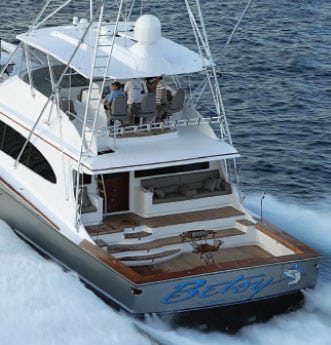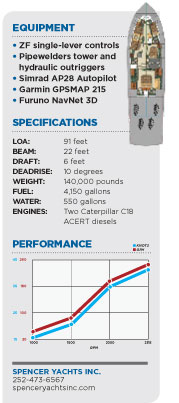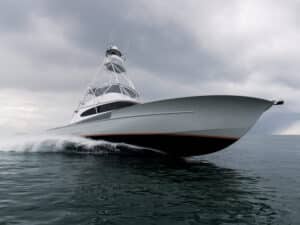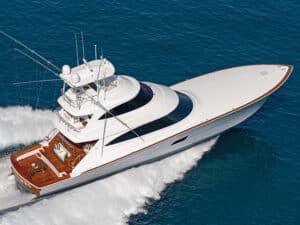
Spencer 87
In the biggest boat Spencer has built to date, he has accomplished exactly what he set out to do.
Performance
Four 1,150 hp Caterpillar engines, coupled to ZF pod-drives with dual counter-rotating props, power this 87 (it actually carries a 91-foot LOA). And that just scratches the surface of the innovative technology that Spencer spoke of incorporating in his boats. The captain slid this leviathan sideways into the Intracoastal from its bulkhead slip and idled us out to sea via the Hillsborough Inlet near Pompano, Florida. Seas ran 3 to 4 feet out of the east. Betsy hardly noticed the nasty little chop.
We experienced little bow rise when rising onto plane, because the thrust from the props runs parallel to the water’s surface, rather than angling down as standard props and shafts do. It planed in a mere seven seconds and hit top speed (just over 40 knots) in 40.
A comfy cruising speed of 34 knots came at 2,022 rpm while burning 160 gph. And remember, that’s with four engines. It will also cruise comfortably at 25 knots (1,500 rpm) on just two engines and at 30 with three.
In addition to having four pods that allow you to move the boat handily in any direction, Betsy also sports a hydraulic bow thruster. Perhaps in a stiff crosswind or foul current, you would need to augment the pods (though I doubt it). What it does do is allow this substantial hull to spin like a Bertram 31, especially in SportFish mode. Cruising along at 32 knots, I turned the wheel hard over, and the Spencer reversed course in an astounding two boat lengths — with hardly any loss of speed! Bottomfishermen in particular will appreciate being able to press a button and have the boat stay in place and on heading automatically.
Engine Room
The engine compartment feels a bit strange with four engines, and yet there’s still more than enough room to work around each power plant. Twin 38 kW Northern Lights generators sit at the forward end of the cavernous space. On centerline, you see a deployable 360-degree scanning sonar by Furuno. The system connects to the GPS, so if you exceed 12 knots with it deployed, it automatically withdraws into its tube.
The Spencer 87, with its beefy ZF 4000 pod-drives, qualifies as the first boat in the world to sport four such units. The carbon-fiber shafts that connect the pods and engines weigh a third of comparable metal shafts. And since four engines require a substantial supply of air, Livos air handlers deliver plenty of it — and remove any salt mist in the process.
Two Neville ice machines hide in the aft tunnel. One supplies a large box under a mezzanine seat, and the other dumps into a large container abutting a cockpit fish box.
Paul Spencer’s innovative trim-tab design boasts quarter-inch stainless-steel plates that will never break, and he mounts the electric actuators inside the hull to let you swap one out without having to jump into the water.
A new fire-suppression system called Pyrogen — an inert, nontoxic solid developed from rocket-fuel technology — protects all interior spaces. This compound remains stable until it is electrically or thermally activated. Pyrogen is not a gas, liquid or solid; it produces extremely fine potassium crystals that act as radical scavengers, inhibiting the combination of hydrogen and oxygen in the flames. This stops the fire at the molecular level and actually cools the fuel. Unlike some other systems, your electronics or turbochargers will suffer no thermal shock if you have to activate this system.
Flybridge

I loved being able to watch the props turning via underwater cameras — an amazing perspective.
Looking forward from the helm, you clearly see most of the foredeck. Spencer installed a freshwater washdown system that cleans salt spray off the outside of the flybridge enclosure while running. Looking aft, you have a clear view of the aft half of the cockpit.
The bridge sports an aft-facing, horseshoe-shaped settee forward of the helm by the brow and a straight settee across the console front with loads of freezer storage beneath.
Cockpit

Today’s obligatory full-width mezzanine seats hide refrigeration, two grills, drink boxes, bait storage and the like underneath them. Tuna tubes hide at the ends of the mezzanine seats. Copying technology from the smaller, high-speed center console, the lid on the livewell seals tightly so you can pressurize it, allowing the expensive and fragile baits to remain in virtual stasis rather than sloshing around and getting bruised.
Pipewelders built the tower and the hydraulic outriggers on either side of the open flybridge. I particularly appreciated the new integral rollers for the outrigger lines — a great alternative to mounting turning block pulleys on eye bolts. Betsy’s new superlightweight outriggers — each a whopping 51 feet long with quad stays — weigh only 45 pounds apiece.
Interior
The galley boasts all Miele appliances, and Sub-Zero made the myriad refrigerator/freezer drawers. Maretron’s OctoPlex electrical distribution system gives you touch-screen control of every system aboard Betsy, with numerous control screens around the boat.

Things get really interesting belowdecks. The first cabin to starboard houses a full gym, complete with an elliptical machine, a rubber floor, weights and more. The full-width master stateroom (22 feet by 17 feet) showcases marble counters with lighting underneath that makes the counters glow. Every berth on Betsy has copious storage underneath and hefty pneumatic shocks to make lifting those posh mattresses easy.
The captain’s sister, Beth Cole, did all the interior decorating, and it whispers understated elegance. I love the lightweight stone perimeters surrounding all the carpets, the lovely designer fixtures and lights, and, most of all, the unusual crown moldings and baseboards throughout.
Crew quarters in the fo’c’sle qualify as downright civilized, and a second crew stateroom provides over/under twin berths rather than narrow singles.
One of my pet peeves on boats concerns wasted space. Press a button in the forward cabin and a hefty hatch in the sole opens, revealing a massive “finished basement” for additional storage. I found no dead space aboard Betsy!

Design and Construction

This Spencer 87 exudes a palpable aura, thanks to its new Alexseal metallic hull paint (with matching hull coating on the Hell’s Bay Marquesa flats skiff mounted on the foredeck). One look stops you in your tracks. The flawless teak toe rail and trim gleam. You’d never guess it’s fabric! It’s a fascinating new product called Air Teak (airteak.com), created by noted yacht designer Steve French. This fabric looks and feels exactly like real teak when it’s applied over fiberglass. It lasts far longer and requires infinitely less maintenance than varnished teak. Additionally, we don’t have to sacrifice anywhere near as many of our planet’s rare hardwood trees! I challenge you to compare the two and tell the difference!
Betsy represents the most advanced laminate schedule Spencer has ever created. The deck and bulkheads were built on a jig with Core-Cell composite foam sandwiched with E-glass (some layers are resin-infused) and all epoxy resins, and Spencer used loads of carbon fiber and Nida-Core composite in them. The composite, combined with the underwater exhausts through the pods, makes the boat exceptionally quiet.
So much is different and unique about this boat that had the owner not named it after his beloved wife, Betsy, he says he would’ve called it Game Changer!
I know I’ve never been aboard another boat like this one. I’ve never said, “Man, I wish this was my boat” until now. Owner Mike Brauser and his crew, along with the Spencers and Steve French at Applied Concepts Unleashed, scored a true masterpiece!







